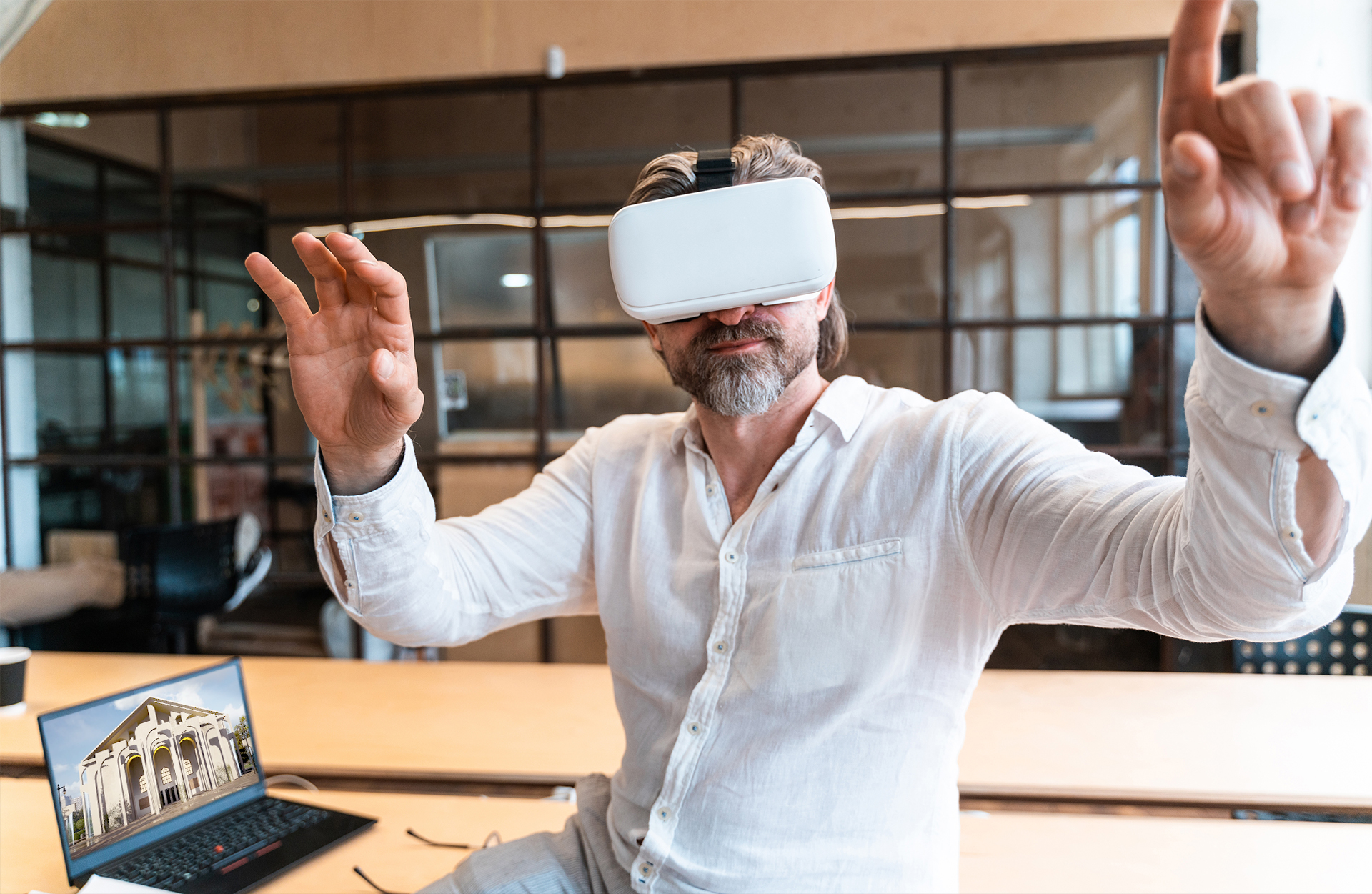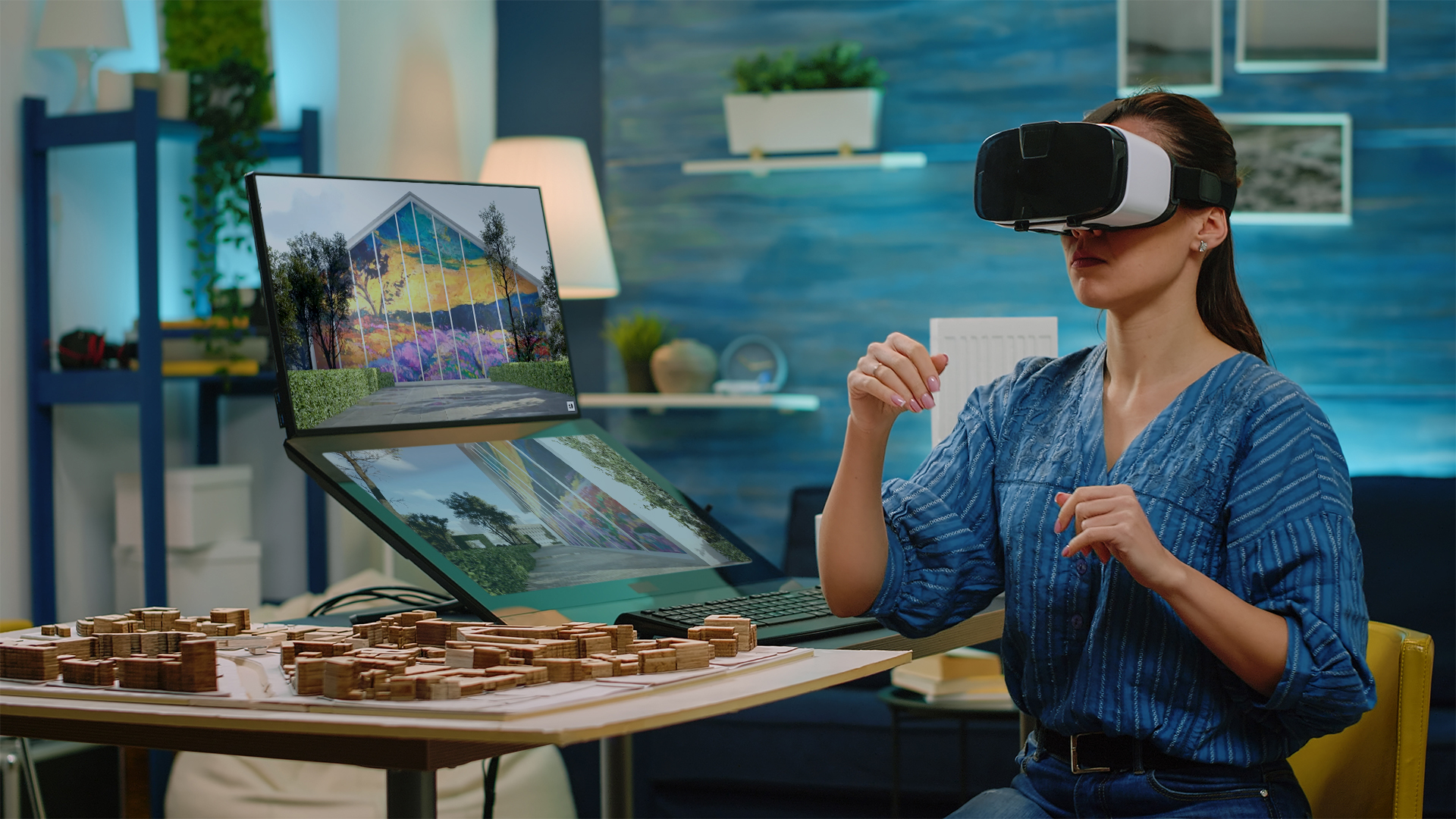The usage of VR in architecture started around 2015 and is becoming more and more widespread. Now, it is used by all kinds of industry players, from giants such as Foster + Partners and Zaha Hadid Architects to emerging firms. So, what are the unique benefits this technology brings to the table? How is virtual reality for architects created and used in practice? And how much does it cost compared to regular 3D renderings?
Our architectural visualization studio has all the answers you need. We work with architects and designers, providing them with top-quality renders and animations as well as interactive AR and VR solutions. And we are happy to share our knowledge on production steps, uses, and advantages of virtual reality assets. So, let’s begin!
What Is VR in Architecture?

Virtual reality for architects is an interactive digital environment that allows one to experience a full immersion into a project. Instead of just looking at drawings or renderings, a person puts on a VR headset — for example, HTC Vive or Meta Quest — and finds themselves inside a yet-to-be-built design. There, one can walk and look around the future building and location. What’s more, it is often possible to interact with some of the design elements using controllers. For instance, a viewer can open and close the windows and doors, switch among different lighting scenarios or surface finishings, move objects, and so on.
The experience can be accompanied by music and realistic sounds. These can be the sounds of steps, chirping birds, pouring water, and more. That makes a VR journey absolutely life-like.
How Is Virtual Reality for Architects Created?
First, using 3D modeling software such as 3ds Max or Blender, a CG artist creates all the objects and environments necessary for visualizing the architectural design. After that, all the assets are exported to Unreal Engine — the best modern tool for creating real-time immersive 3D experiences.
In UE, an artist sets up the lighting and materials. At this point, the intermediate results look pretty similar to regular visualizations made in 3ds Max, as you can see in the image below.

Then, using Unreal Engine, an artist designs all the features for the first-user virtual reality experience. They program interactive objects to make them responsive to a viewer’s use of the controllers. Also, an artist adds music as well as other sounds and links them to a user’s actions where necessary. For instance, a CG expert can make sure that a viewer hears the murmur of water when coming closer to a fountain. Overall, at this stage, it is possible to design literally any experience architects want for the final result. With virtual reality, the sky’s the limit.
The final stage is optimizing all the created assets and compiling them into a folder that contains a .exe file. By opening that file, architects and their clients can start the VR running, just like a computer game. Below, you can see how the resulting visualization looks and works for a person who puts on a virtual reality headset.
On the technical side, this VR experience is actually a game. The only difference is that its mechanics are designed for architectural visualization purposes.
What Is the Cost and Production Time of Virtual Reality for Architects?

The answer depends on the architects’ creativity and requirements for the VR experience. Let’s say you want a simple virtual reality visualization, like the one above where a user just takes a walk around the location. In this case, the cost and turnaround time of a project would be around 20-30% higher than those of an architectural 3D animation for a similar scene.
However, if you wish a virtual reality journey to be longer and include more interactive features, the timing and budget are likely to go up. To get an exact quote for VR projects, architects should contact our client managers.
The Uses of VR for Architects
Virtual reality can benefit architecture specialists at two crucial stages of their work: designing and presenting projects. Let’s see how.
Virtual Reality for Architects at the Design Stage

VR technology streamlines the architectural design process to a great extent. Architects can use VR to review the model of the future building with their team inside a life-like simulation in the early stages of a project. This way, it is easy to make sure that all the team members and stakeholders are on the same page. It can be harder to achieve that with 2D drawings or even 3D renders, especially with remote workers.
With the level of realism available in VR, architects can spot design errors and come up with the best way to improve the project easier and quicker than ever. That means that when it comes to the presentation, they will be able to showcase the most refined and polished version of their work.
Virtual Reality for Architects at the Presentation Stage

There is no match for VR in terms of presenting architectural projects. No other technology allows one’s clients to get such a comprehensive, immersive, and realistic impression of the future place.
With VR, architects do not need to go into detail about technicalities and other design aspects because the client sees everything with their own eyes. After viewing the project in virtual reality, a person feels like they’ve actually visited the place that is yet to be built. This way, VR creates a truly memorable experience and a deeper emotional connection to a project. Also, it paves the way for giving better, clearer feedback to the architect.
Virtual reality is a game-changing tool that makes things easier for both architects and their clients. It provides architecture specialists with the opportunity to create great designs much faster and makes the entire process more interesting and collaborative than before. And clients, in turn, can enjoy breathtaking, fully immersive presentations that feel more like a mix of a time travel and computer game experience.
Get your project estimated in just 1 hour - fill out this brief!
Looking for innovative 3D solutions to design and present your architectural projects? Contact us for 3D rendering services and get high-quality CG images, animations, AR, or VR assets at a reasonable price!
Catherine Paul Catherine is a content writer and editor. In her articles, she explains how CGI is transforming the world of architecture and design. Outside of office, she enjoys yoga, travelling, and watching horrors.
Content Writer, Editor at ArchiCGI




